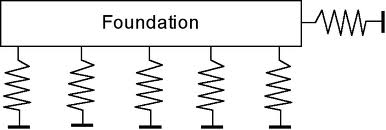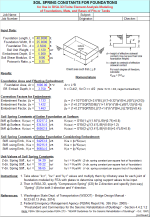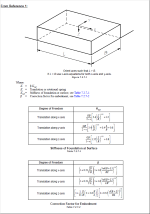SOIL SPRING CONSTANTS FOR FOUNDATIONS

Description
"SPRING-K" --- SOIL SPRING CONSTANTS FOR FOUNDATIONS
Program Description:
"SPRING-K" is a spreadsheet program written in MS-Excel for the purpose of determining the soil spring constants for foundations for the vertical direction (Z), as well as for the horizontal directions (X and Y). Specifically, the soil spring constants, both at the surface and at a user input embedment depth, are determined in the analysis. The soil spring constants obtained from the analysis can then be readily used and input into RISA-3D finite element analysis computer models of foundations, mats, and bases of pits or tanks. (Note: instructions for use are provided at the end of the calculation worksheet.)
This program is a workbook consisting of two (2) worksheets, described as follows:
Worksheet Name - Description
Doc - This documentation sheet
Soil Spring Constants - Soil spring constants analysis for foundations, mats, and bases of pits/tanks
Program Assumptions and Limitations:
1. This program is based on the following references:
a. Washington State Dept. of Transportation (WSDOT) - Bridge Design Manual - M 23-50.13 (Feb. 2014)
b. Federal Emergency Management Agency (FEMA) Report No. 356 (Nov. 2000) -
"Prestandard and Commentary for the Seismic Rehabilitation of Buildings" - Section 4.4.2.1.2
(Note: FEMA 356 supercedes FEMA 273 - "NEHRP Guidelines for the Seismic Rehabilitation of Buildings" - Oct. 1997)
c. "Foundation Analysis and Design", Fifth Edition - by Joseph E. Bowles, P.E., S.E. (McGraw-Hill, 1997)
d. "Vibrating Machinery Foundations on Soil (Using Frequency Dependent Criteria)" -
Guideline 000.215.1233 (Aug. 18, 2005) - Fluor Corporation
2. While the instructions herein are specifically noted for use with the RISA-3D computer analysis software (by RISA Technologies, LLC), the results should be equally applicable for use in most other finite element computer analysis software programs.
3. If the unit soil spring constant for the z-direction (vertical) has been provided by the geotechnical consultant, then that value obtained from a plate load test should be adjusted to reflect the plan size of the foundation. Finally, that adjusted value may then be multiplied by the Embedment Factor, bz, (from the calculation worksheet) to arrive at the design value for the z-direction to reflect embedment, in lieu of using the value obtained from the calculation worksheet. (Note: Refer to section on adjusting the Geotechnical Consultant provided plate load test k-value to reflect the full plan size (area) of the foundation. This section is located off of the page and to the right.)
4. This program contains “comment boxes” which contain a wide variety of information including explanations of input or output items, equations used, data tables, etc. (Note: presence of a “comment box” is denoted by a “red triangle” in the upper right-hand corner of a cell. Merely move the mouse pointer to the desired cell to view the contents of that particular "comment box".)
Calculation Reference
Soil Mechanics
Soil Stiffness
Geotechnics
Calculation Preview
Full download access to any calculation is available to users with a paid or awarded subscription (XLC Pro).
Subscriptions are free to contributors to the site, alternatively they can be purchased.
Click here for information on subscriptions.


